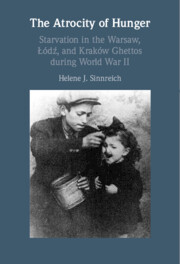Book contents
- The Atrocity of Hunger
- The Atrocity of Hunger
- Copyright page
- Dedication
- Contents
- Figures
- Tables
- Acknowledgments
- Introduction
- 1 The Nazi Invasion
- 2 Jewish Leadership
- 3 The Supply and Distribution of Food
- 4 The Physical, Mental, and Social Effects of Hunger
- 5 Hunger and Everyday Life in the Ghetto
- 6 Socioeconomic Status and Food Access
- 7 Relief Systems and Charity
- 8 Illicit Food Access
- 9 Labor and Food in the Ghettos
- 10 Deportations and the End of the Ghettos
- Conclusion
- Appendix: List of Kitchens and Food Distribution Sites in the Warsaw Ghetto
- Notes
- Bibliography
- Index
- References
Bibliography
Published online by Cambridge University Press: 09 February 2023
- The Atrocity of Hunger
- The Atrocity of Hunger
- Copyright page
- Dedication
- Contents
- Figures
- Tables
- Acknowledgments
- Introduction
- 1 The Nazi Invasion
- 2 Jewish Leadership
- 3 The Supply and Distribution of Food
- 4 The Physical, Mental, and Social Effects of Hunger
- 5 Hunger and Everyday Life in the Ghetto
- 6 Socioeconomic Status and Food Access
- 7 Relief Systems and Charity
- 8 Illicit Food Access
- 9 Labor and Food in the Ghettos
- 10 Deportations and the End of the Ghettos
- Conclusion
- Appendix: List of Kitchens and Food Distribution Sites in the Warsaw Ghetto
- Notes
- Bibliography
- Index
- References
Summary
- Type
- Chapter
- Information
- The Atrocity of HungerStarvation in the Warsaw, Lodz, and Krakow Ghettos during World War II, pp. 268 - 280Publisher: Cambridge University PressPrint publication year: 2023
- Creative Commons
- This content is Open Access and distributed under the terms of the Creative Commons Attribution licence CC-BY-NC-ND 4.0 https://creativecommons.org/cclicenses/



